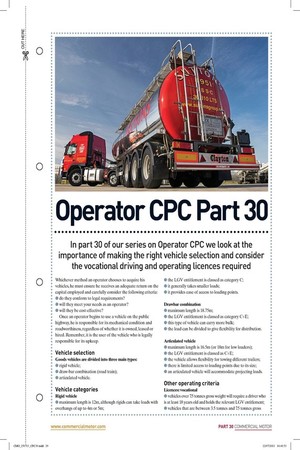Operator CPC Part 30 In part 30 of our series
Page 24

Page 25

If you've noticed an error in this article please click here to report it so we can fix it.
on Operator CPC we look at the importance of making the right vehicle selection and consider the vocational driving and operating licences required Whichever method an operator chooses to acquire his vehicles, he must ensure he receives an adequate return on the capital employed and carefully consider the following criteria: • do they conform to legal requirements?
• will they meet your needs as an operator?
• will they be cost-effective?
Once an operator begins to use a vehicle on the public highway, he is responsible for its mechanical condition and roadworthiness, regardless of whether it is owned, leased or hired. Remember, it is the user of the vehicle who is legally responsible for its upkeep.
Vehicle selection Goods vehicles are divided into three main types: • rigid vehicle; • draw-bar combination (road train); • articulated vehicle.
Vehicle categories Rigid vehicle • the LGV entitlement is classed as category C; • it generally takes smaller loads; • it provides ease of access to loading points.
Drawbar combination • maximum length is 18.75m; • the LGV entitlement is classed as category C+E; • this type of vehicle can carry more bulk; • the load can be divided to give flexibility for distribution.
Articulated vehicle • maximum length is 16.5m (or 18m for low loaders); • the LGV entitlement is classed as C+E; • the vehicle allows flexibility for towing different trailers; • there is limited access to loading points due to its size; • an articulated vehicle will accommodate projecting loads.
Other operating criteria Licences: vocational vehicles over 7.5 tonnes gross weight will require a driver who is at least 18 years old and holds the relevant LGV entitlement; • vehicles that are between 3.5 tonnes and 7.5 tonnes gross weight again require a driver who is at least 18 years old, but only require a Cl licence entitlement. Licences: operator • goods vehicles that exceed 3.5 tonnes plated weight (or 1,525kg unladen weight if unplated), that are used to carry goods in connection with a business will require one of the following types of operator licence: Standard — for hire or reward; Restricted — for `own-account' work.
An operator's choice of vehicle size, type and bodywork will clearly be influenced by the nature of the work to be undertaken. A few options are: • a tipper for site work; • a tanker for bulk liquids or gases; • a large volume body for furniture; • an artic/drawbar for trunk work; • a van for local distribution; • low gearing for urban work; • high gearing/overdrive for motorways.
Additionally, there are several types of load handling equipment to make the distribution of goods easier. Typical examples include: • pallets — loaded and off-loaded by forklift trucks; • roll cages — used in conjunction with a vehicle's tail-lift; • roller-beds — used commonly for aircraft pallets. When selecting new equipment, an operator should consider the following environmental issues: • fuel economy; • vehicle emissions (Euro engine standards); • fuel and lubricants (ultra-low-sulphur diesel). The comfort of vehicle crew is also of paramount importance. The following points should be considered: • air conditioning; • higher powered engines to reduce driveline wear and minimise driver fatigue; • automatic gearboxes and cruise control.
All operators should carry out a risk assessment to ensure working practices are safe. If necessary, they should be prepared to draw up safe working procedures and provide training to drivers and other members of staff as and when required.
Finally, let's conclude with a look at some vehicle definitions in order to understand the variety available to an operator: motor vehicle: a mechanically propelled vehicle constructed or permanently adapted principally for use on the public highway; goods vehicle: a motor vehicle or trailer constructed or permanently adapted principally for the carriage of goods; * dual-purpose vehicle: a motor vehicle constructed or permanently adapted to carry goods and passengers, with an unladen weight not exceeding 2,040kg (2 tons); * motor tractor: non load-carrying vehicle with an unladen weight not exceeding 7,370kg (7.25 tons); * light locomotive: non load-carrying vehicle with an unladen weight exceeding 7,370kg (7.25 tons) but not exceeding 11,690kg (11.5 tons); * heavy locomotive: non load-carrying vehicle with an unladen weight exceeding 11,690kg (11.5 tons); ** small (light) goods vehicle: goods vehicle with a permissible maximum weight (including any trailer), not exceeding 3,500kg; ** medium goods vehicle: goods vehicle with a permissible maximum weight (including any trailer), exceeding 3,500kg but not exceeding 7,500kg; ** large goods vehicle: a goods vehicle with a permissible maximum weight exceeding 7,500kgs and any articulated goods vehicle; rigid vehicle: a motor vehicle not constructed or adapted to form part of an articulated vehicle; articulated vehicle: a motor vehicle/semi-trailer combination where at least 20% of the uniformly laden weight of the semi-trailer is borne by the drawing vehicle. This is normally achieved by means of a fifth-wheel coupling; semi-trailer: not self-standing and forms part of an articulated vehicle; places at least 20% of its weight on the drawing vehicle; steering drawbar trailer: having at least four wheels, supports itself and is steerable; close-coupled drawbar trailer: a drawbar trailer with nonsteerable wheels, with two or three axles. The axle centres are not more than one metre apart; composite trailer: a semi-trailer used with a converter dolly, thereby turning it into a drawbar trailer.
* Older imperial weight definitions are based on unladen weight ** Current metric definitions are based on gross weight • These notes endeavour to reflect the legislation applicable to the Certificate of Professional Competence syllabus. Commercial Motor and EP Training do not accept responsibility for omissions or incorrect interpretation of the legislation. Candidates should refer to the appropriate Acts and Statutory Instruments for clarification.










































